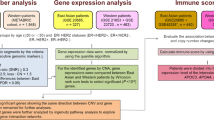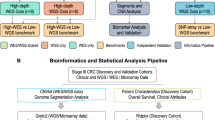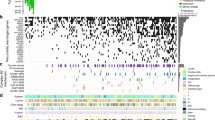Abstract
Homozygous loss in the genomic sequence, a mechanism for inactivating tumor-suppressor genes (TSGs) in cancer, has been used as a tag for the identification of novel TSGs, and array-based comparative genomic hybridization (array-CGH) has a great potential for high-throughput identification of this change. We identified a homozygous loss of the very-low-density lipoprotein receptor (VLDLR) gene (9p24.2) from genome-wide screening for copy-number alterations in 32 gastric cancer (GC) cell lines using array-CGH. Although previous reports demonstrated mRNA or protein expression of VLDLR in various cancers including GC, the association between genomic losses or epigenetic silencing of this gene and carcinogenesis has never been reported before. Homozygous deletion of VLDLR was also seen in primary GCs, albeit infrequently, and about half of GC cell lines showed lost or reduced VLDLR expression. The VLDLR expression was restored in gene-silenced GC cells after treatment with 5-aza 2′-deoxycytidine. According to methylation analyses, hypermethylation of the VLDLR promoter region, which all of GC lines without its expression showed, occurred in some primary GCs. Restoration of VLDLR type I expression in GC cells reduced colony formation. These results suggest that not only the expression of VLDLR but also genetic or epigenetic silencing of this gene may contribute to tumor formation and be involved in gastric carcinogenesis.
This is a preview of subscription content, access via your institution
Access options
Subscribe to this journal
Receive 50 print issues and online access
$259.00 per year
only $5.18 per issue
Buy this article
- Purchase on Springer Link
- Instant access to full article PDF
Prices may be subject to local taxes which are calculated during checkout





Similar content being viewed by others
References
An HX, Claas A, Savelyeva L, Seitz S, Schlag P, Scherneck S et al. (1999). Cancer Res 59: 3941–3943.
Baylin SB, Herman JG, Graff JR, Vertino PM, Issa JP . (1998). Adv Cancer Res 72: 141–196.
Chen T, Wu F, Chen FM, Tian J, Qu S . (2005). World J Gastroenterol 11: 2817–2821.
Chen WJ, Goldstein JL, Brown MS . (1990). J Biol Chem 265: 3116–3123.
D'Arcangelo G, Homayouni R, Keshvara L, Rice DS, Sheldon M, Curran T . (1999). Neuron 24: 471–479.
Fukuda Y, Kurihara N, Imoto I, Yasui K, Yoshida M, Yanagihara K et al. (2000). Genes Chromosomes Cancer 29: 315–324.
Heidenblad M, Schoenmakers EF, Jonson T, Gorunova L, Veltman JA, van Kessel AG et al. (2004). Cancer Res 64: 3052–3059.
Hembrough TA, Ruiz JF, Papathanassiu AE, Green SJ, Strickland DK . (2001). J Biol Chem 276: 12241–12248.
Hiltunen TP, Luoma JS, Nikkari T, Yla-Herttuala S . (1998). Circulation 97: 1079–1086.
Inazawa J, Inoue J, Imoto I . (2004). Cancer Sci 95: 559–563.
Kim SK, Ro JY, Kemp BL, Lee JS, Kwon TJ, Fong KM et al. (1997). Cancer Res 57: 400–403.
Martensen PM, Oka K, Christensen L, Rettenberger PM, Petersen HH, Christensen A et al. (1997). Eur J Biochem 248: 583–591.
Nakamura Y, Yamamoto M, Kumamaru E . (2000). Arch Pathol Lab Med 124: 119–122.
Near SE, Wang J, Hegele RA . (2001). J Hum Genet 46: 490–493.
Noguchi M, Furuya S, Takeuchi T, Hirohashi S . (1997). Pathol Int 47: 685–691.
Reisman DN, Sciarrotta J, Wang W, Funkhouser WK, Weissman BE . (2003). Cancer Res 63: 560–566.
Sakai J, Hoshino A, Takahashi S, Miura Y, Ishii H, Suzuki H et al. (1994). J Biol Chem 269: 2173–2182.
Sakata K, Tamura G, Maesawa C, Suzuki Y, Terashima M, Satoh K et al. (1995). Jpn J Cancer Res 86: 333–335.
Sarkar S, Roy BC, Hatano N, Aoyagi T, Gohji K, Kiyama R . (2002). J Biol Chem 277: 36585–36591.
Sato M, Takahashi K, Nagayama K, Arai Y, Ito N, Okada M et al. (2005). Genes Chromosomes Cancer 44: 405–414.
Sato N, Fukushima N, Chang R, Matsubayashi H, Goggins M . (2006). Gastroenterology 130: 548–565.
Shim YH, Kang GH, Ro JY . (2000). Lab Invest 80: 689–695.
Sonoda I, Imoto I, Inoue J, Shibata T, Shimada Y, Chin K et al. (2004). Cancer Res 64: 3741–3747.
Strickland DK, Kounnas MZ, Argraves WS . (1995). FASEB J 9: 890–898.
Suzuki J, Takahashi S, Oida K, Shimada A, Kohno M, Tamai T et al. (1995). Biochem Biophys Res Commun 206: 835–842.
Takada H, Imoto I, Tsuda H, Nakanishi Y, Ichikura T, Mochizuki H et al. (2005b). Oncogene 24: 8051–8060.
Takada H, Imoto I, Tsuda H, Sonoda I, Ichikura T, Mochizuki H et al. (2005a). Cancer Sci 96: 100–110.
Takahashi S, Kawarabayasi Y, Nakai T, Sakai J, Yamamoto T . (1992). Proc Natl Acad Sci USA 89: 9252–9256.
Takahashi S, Suzuki J, Kohno M, Oida K, Tamai T, Miyabo S et al. (1995). J Biol Chem 270: 15747–15754.
Tanabe C, Aoyagi K, Sakiyama T, Kohno T, Yanagitani N, Akimoto S et al. (2003). Genes Chromosomes Cancer 38: 168–176.
Tanami H, Tsuda H, Okabe S, Iwai T, Sugihara K, Imoto I et al. (2005). Lab Invest 85: 1118–1129.
Vo QN, Geradts J, Boudreau DA, Bravo JC, Schneider BG . (2002). Hum Pathol 33: 1200–1204.
Wada Y, Homma Y, Nakazato K, Ishibashi T, Maruyama Y . (2000). Heart Vessels 15: 74–80.
Webb DJ, Nguyen DH, Sankovic M, Gonias SL . (1999). J Biol Chem 274: 7412–7420.
Webb JC, Patel DD, Jones MD, Knight BL, Soutar AK . (1994). Hum Mol Genet 3: 531–537.
Xiong Z, Laird PW . (1997). Nucleic Acids Res 25: 2532–2534.
Yamano M, Fujii H, Takagaki T, Kadowaki N, Watanabe H, Shirai T . (2000). Am J Pathol 156: 2123–2133.
Yuki Y, Imoto I, Imaizumi M, Hibi S, Kaneko Y, Amagasa T et al. (2004). Cancer Sci 95: 503–507.
Acknowledgements
We are grateful to Professor Yusuke Nakamura (Human Genome Center, The Institute of Medical Science, The University of Tokyo) for his continuous encouragement throughout this work. We thank Professor Jae-Gahb Park (Laboratory of Cell Biology, Cancer Research Institute, Seoul National University College of Medicine) and Dr Kazuyoshi Yanagihara (Central Animal Laboratory, National Cancer Center Research Institute) for providing GC cell lines and Ai Watanabe for technical assistance.This work was supported by Grants-in-Aid for Scientific Research on priority areas (C) from the Ministry of Education, Culture, Sports, Science and Technology, Japan; by a Grant-in-Aid from Core Research for Evolutional Science and Technology (CREST) of the Japan Science and Technology Corporation (JST); by a Center of Excellence (COE) program for Frontier Research on Molecular Destruction and Reconstitution of Tooth and Bone; by the program for promotion of Fundamental Studies in Health Sciences of the Pharmaceuticals and Medical Devices Agency (PMDA); and by the Third Term Comprehensive Control Research for Cancer of the Ministry of Health, Labour and Welfare.
Author information
Authors and Affiliations
Corresponding author
Rights and permissions
About this article
Cite this article
Takada, H., Imoto, I., Tsuda, H. et al. Genomic loss and epigenetic silencing of very-low-density lipoprotein receptor involved in gastric carcinogenesis. Oncogene 25, 6554–6562 (2006). https://doi.org/10.1038/sj.onc.1209657
Received:
Revised:
Accepted:
Published:
Issue Date:
DOI: https://doi.org/10.1038/sj.onc.1209657
Keywords
This article is cited by
-
Up-regulated expression of type II very low density lipoprotein receptor correlates with cancer metastasis and has a potential link to β-catenin in different cancers
BMC Cancer (2010)
-
PRTFDC1, a possible tumor-suppressor gene, is frequently silenced in oral squamous-cell carcinomas by aberrant promoter hypermethylation
Oncogene (2007)
-
Genetic analysis of multifocal superficial urothelial cancers by array-based comparative genomic hybridisation
British Journal of Cancer (2007)



